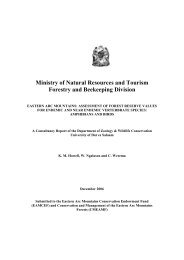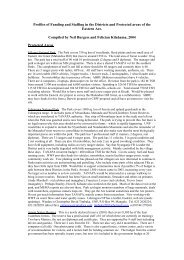Butterfly Farming in the East Usambara Mountains - Eastern Arc ...
Butterfly Farming in the East Usambara Mountains - Eastern Arc ...
Butterfly Farming in the East Usambara Mountains - Eastern Arc ...
You also want an ePaper? Increase the reach of your titles
YUMPU automatically turns print PDFs into web optimized ePapers that Google loves.
4) The <strong>Butterfly</strong> <strong>Farm<strong>in</strong>g</strong> Rout<strong>in</strong>e<br />
This section describes <strong>the</strong> butterfly farm<strong>in</strong>g system that I have developed over <strong>the</strong> past year and a<br />
half. There are many different techniques for farm<strong>in</strong>g butterflies, but I believe that <strong>the</strong> follow<strong>in</strong>g<br />
rout<strong>in</strong>e is <strong>the</strong> best for <strong>the</strong> <strong>East</strong> <strong>Usambara</strong> Mounta<strong>in</strong>s.<br />
4.1 Morn<strong>in</strong>g activities<br />
• Collect<strong>in</strong>g seeds and seedl<strong>in</strong>gs of host plant species that are needed <strong>in</strong> <strong>the</strong> nursery. This<br />
task requires a lot of work dur<strong>in</strong>g <strong>the</strong> <strong>in</strong>itial few months of preparation for butterfly<br />
farm<strong>in</strong>g. After a large and healthy nursery is established, this task become unnecessary,<br />
except to replace plants that have grown too big every few years.<br />
• Water<strong>in</strong>g – If <strong>the</strong> wea<strong>the</strong>r is dry water<strong>in</strong>g might be needed every o<strong>the</strong>r morn<strong>in</strong>g. If wet<br />
water<strong>in</strong>g may not be necessary.<br />
• Weed<strong>in</strong>g – Conducted if needed.<br />
• Fertiliz<strong>in</strong>g – Conducted every month or so.<br />
• Chang<strong>in</strong>g Fake Flowers – Butterflies that are nectar feeders often do not like alcohol so it<br />
is important to change fake flowers every day so that <strong>the</strong> sugar water does not ferment.<br />
• Chang<strong>in</strong>g Fruit Pieces – Mango is a very good fruit for most butterfly species that enjoy<br />
ferment<strong>in</strong>g fruit. However, <strong>the</strong> fruit pieces should be changed if <strong>the</strong>y are dry or<br />
particularly sour.<br />
• Check<strong>in</strong>g <strong>the</strong> Egg Conta<strong>in</strong>ers – Conta<strong>in</strong>ers that are used to ga<strong>the</strong>r eggs should be checked<br />
every morn<strong>in</strong>g for newly hatched larvae. These larvae should <strong>the</strong>n be placed on young<br />
leaves of <strong>the</strong>ir appropriate food plants <strong>in</strong> <strong>the</strong> larvae-rear<strong>in</strong>g cage us<strong>in</strong>g a small pa<strong>in</strong>tbrush.<br />
• Check<strong>in</strong>g <strong>the</strong> Pupae Cage – The small net box used to hold ei<strong>the</strong>r p<strong>in</strong>ned or glued pupae<br />
should be checked every morn<strong>in</strong>g for newly emerged butterflies. Newly emerged<br />
butterflies should be allowed to dry <strong>the</strong>ir w<strong>in</strong>gs for at least 2 hours before <strong>the</strong>y are<br />
handled.<br />
• Hang<strong>in</strong>g New Pupae - The larvae cage should be checked every morn<strong>in</strong>g for newly<br />
formed pupae. Pupae should be 24 hours old before <strong>the</strong>y are handled to allow sufficient<br />
time for <strong>the</strong>ir sk<strong>in</strong> to dry. Dry pupae should be glued to a stick or p<strong>in</strong>ned to a board and<br />
placed <strong>in</strong> a net box.<br />
• Catch<strong>in</strong>g Female Butterflies – Female butterflies of most species are most visible at<br />
flowers and <strong>in</strong> sunny areas, <strong>in</strong> <strong>the</strong> morn<strong>in</strong>g between 8 and 11 AM. This is <strong>the</strong> period of<br />
day when <strong>the</strong>y are load<strong>in</strong>g up on nectar or fruit sources before <strong>the</strong>y enter <strong>the</strong> forest to<br />
beg<strong>in</strong> to lay eggs. This task is <strong>the</strong> most time consum<strong>in</strong>g <strong>in</strong> <strong>the</strong> early phases of farm<strong>in</strong>g,<br />
and is frequently a futile effort. Fortunately, it becomes unnecessary after captive<br />
populations are established from 3 to 6 females of each species.<br />
4.2 Mid-day activities<br />
• Catch<strong>in</strong>g Male Butterflies – Male butterflies are needed to ma<strong>in</strong>ta<strong>in</strong> genetic diversity <strong>in</strong><br />
<strong>the</strong> captive populations. For <strong>the</strong> first generation, which is usually small, it is beneficial<br />
to replace all <strong>the</strong> males <strong>in</strong> <strong>the</strong> captive populations with wild caught males. Male<br />
butterflies are very active around mid-day, patroll<strong>in</strong>g along <strong>the</strong> forest edge or on hilltops<br />
wait<strong>in</strong>g for female butterflies to pass through <strong>the</strong>ir open<strong>in</strong>g.<br />
4.3 Even<strong>in</strong>g activities<br />
25













